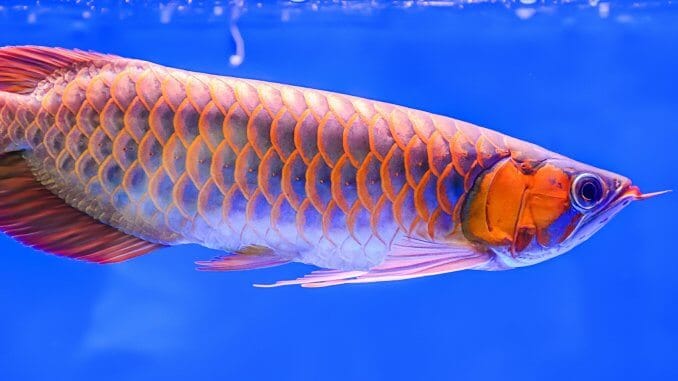
Most people start fishkeeping with a group of small peaceful fish, but after gaining some experience find themselves looking for a bigger challenge.
The Red Arowana is definitely a bigger challenge – it is so big that you will struggle to find a suitable tank.
This species is worth your time and effort though. Its beauty and rarity have made it a prized fish for any enthusiast, and they are easier to care for than you might think.
In this article, we will help you prepare to keep a Red Arowana. We will talk about tank setup, diet, care, and much more…
TABLE OF CONTENTS
Red Arowana Facts & Overview
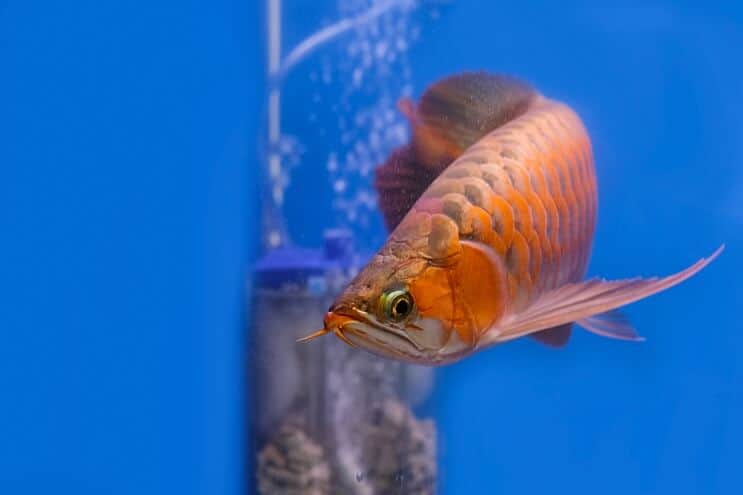
| Category | Rating |
| Care Level: | Intermediate |
| Temperament: | Semi-agressive |
| Color Form: | Red |
| Lifespan: | Over 20 years |
| Size: | 35 inches |
| Diet: | Carnivore |
| Family: | Osteoglossidae |
| Minimum Tank Size: | 250 gallons |
| Tank Set-Up: | Freshwater, plenty of open swimming space |
| Compatibility: | Singly or community of tough fish |
The Red Arowana (Scleropages formosus) is an ancient aquarium fish from the Osteoglossidae family.
They are often confused with Silver Arowanas (Osteoglossum bicirrhosum), but these fish are found across the other side of the world, in South America.
Red Arowanas go by many names including Super Red, Blood Red or Chili Red Arowanas.
These fish are significant in Chinese culture because they resemble the Chinese dragon (which has given them the nickname Dragonfish).
Keeping this species is a big commitment.
A healthy fish will easily reach 20 years old, but there are reports of these fish living for up to 60. They don’t come cheap either – usually, they cost $100 to $5,000, but some have been sold for around $300,000.
They are currently an endangered species so cannot be fished and must be bred under license – those that leave Asia are microchipped.
Typical Behavior
They swim in the middle of the tank but will venture higher and lower from time to time.
These fish are highly territorial and tend to fight with nearby fish however you can occasionally find an Arowana with a more placid personality.
Keeping them in their own tank will prevent any fighting.
Red Arowanas are a hardy species that can tolerate a range of conditions. They may not look it, but they are actually fairly easy to care for.
Appearance
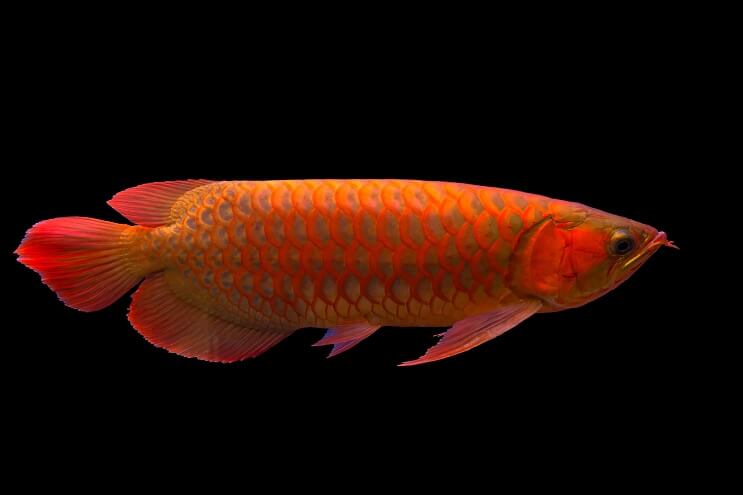
The first thing to note about their appearance is their size. They can reach a massive 35 inches once they mature. This is too big for most people to keep and is one of the main reasons that they are not common in aquariums.
They look similar to Silver Arowanas from South America. Both species have the characteristic jawline known as a drawbridge because their mouths are steeply angled.
Their bodies are covered in large scales arranged in 5 horizontal rows. Each scale has three colors: a base color, a 1st rim, and a second rim. A Red Arowana’s scales have bright red rims, sometimes around a gold base color.
Other notable features include large black eyes right next to the mouth and long pectoral fins joined just behind the head. They have broader anal, tail, and dorsal fins at the rear.
The fins work with the muscular body to create powerful movements through the water- they can jump over 6 feet above the water surface!
They have many teeth and a bone in their mouth, giving them the nickname Bony tongue.
Red Arowanas are just one variety of Asian Arowana, other varieties can be green, gold, or have colored tails.
Habitat and Tank Conditions
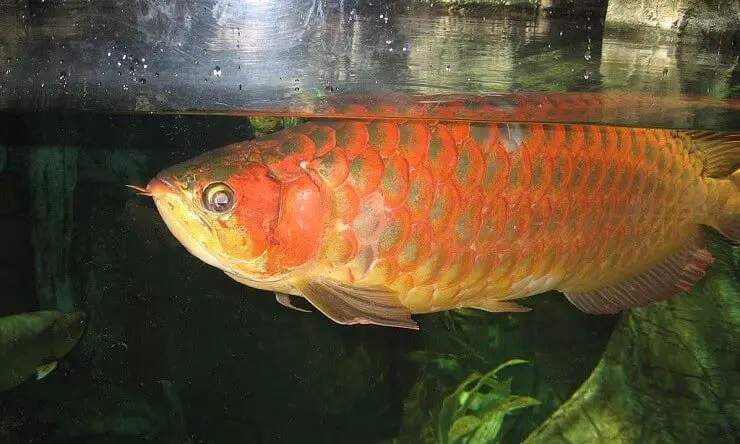
These fish are indigenous to Southeast Asia and swim in slow-moving rivers and streams. Therefore, they need a tropical freshwater aquarium if you want to keep one.
The warm water is usually acidic but can be alkaline in some areas.
These rivers are large, leaving plenty of space for swimming and jumping from the water. The riverbed would be a fine substrate with just a few plants, rocks and debris.
Tank Setup
You should start with a fine-grained substrate (sand is your best choice).
Try to be sparing with decorations and plants. This species does not tend to hide and will need large open swimming spaces. Any plants you add need to be firmly rooted in the substrate as your Arowanas might dislodge them.
As for water conditions, the ideal pH is 6, and the temperature is 75-86°F.
The only equipment you need is a filter and a heater.
You will also need a tight-fitting lid to stop your Arowana from jumping out the tank.
What Size Aquarium Do They Need?
A fully grown Red Arowana needs at least a 250-gallon tank.
If the tank is too small, their body could develop deformed and they will have a shorter lifespan.
Each additional Red Arowana needs another 100 gallons.
Tank Mates
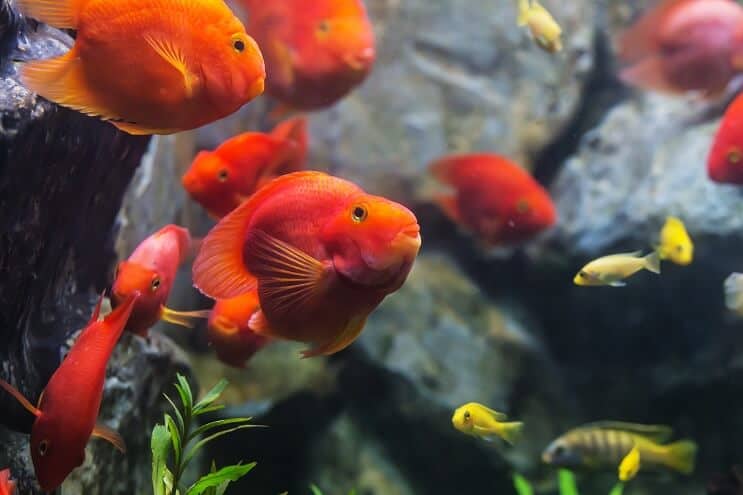
Finding the right tank mates for a Red Arowana can be difficult, but there are some good options out there. They need to be able to deal with an unpredictable temperament.
Oscars, knifefish, blood parrot cichlids, convict cichlids, discus, angelfish, large plecostomus, catfish, green terrors, and stingrays are a few suitable companions.
This species has a very large mouth, and any fish that are small enough to fit inside will be eaten. So avoid small tank mates like tetras and guppies.
Most freshwater invertebrates are small too and will likely be treated as a snack.
Any fish that swim in the upper levels of the tank will get in the way of your Arowana and will be at greater risk.
You may find that your Red Arowana regularly gets into fights with tank mates. If this happens, you will have to separate it. Each individual has their own personality, which can be unpredictable, so keep an eye on them.
Keeping Red Arowanas Together
Due to their territorial nature, keep them either on their own or in groups of at least six.
Diet
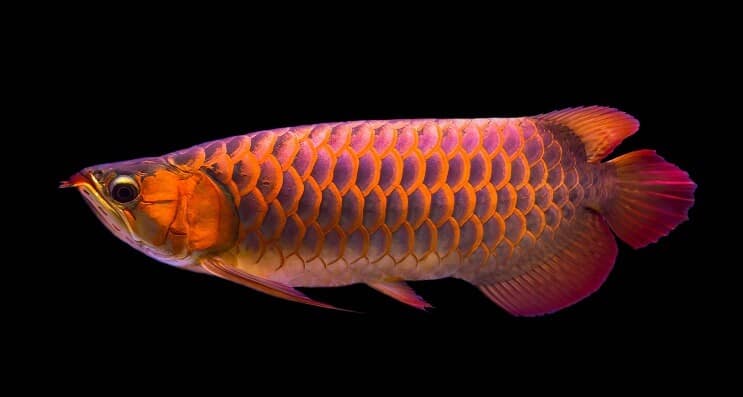
This is a carnivorous fish that prefers meaty foods (live foods are their favorite). These are highly nutritious and do not sink straight to the bottom of the tank.
There are many food options: crickets, mealworms, flies, small frogs, bloodworms, shrimp and many more. They will eat small fish too (including poorly chosen tankmates).
Each individual has their own preference, so try a few foods before settling on a regular diet.
You should vary the food every so often. For example, foods with high protein (like mealworms) often lack other nutritional content. Variation also keeps feeding times interesting for your fish.
Foods with high carotenoid levels are great for maintaining the vibrant red coloration of your Arowanas.
It is important that their food floats on the surface or within the water column since Arowanas don’t generally eat from the floor. This can mean that uneaten food is left to decay, so it is best to invest in a bottom-feeding fish to clean up. Otherwise, you will have to remove the excess food yourself.
Feed small fish 1-2 times a day until they lose interest. Once they reach 12 inches long, feeding once every 2 days is fine.
Care
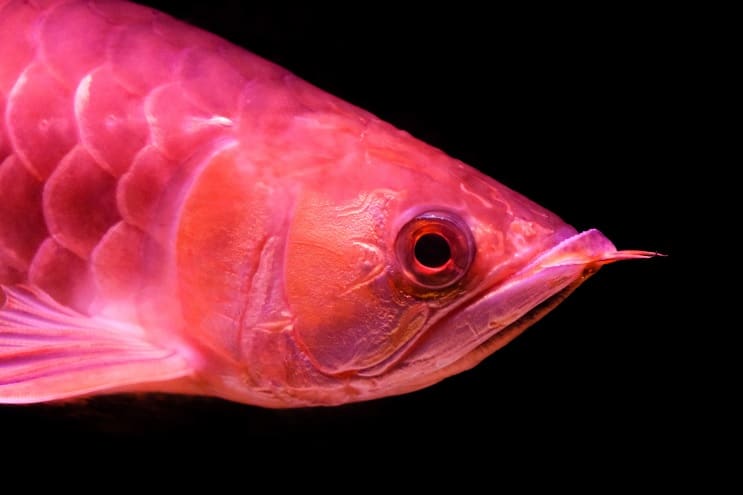
This large, territorial species is well able to defend itself from attackers, so they don’t pick up many injuries. They are hardy fish that tolerates a wide range of conditions. These factors make them much easier to care for than other exotic fish.
They may be tolerant to poor conditions, but they can’t cope with changing conditions, so keep it consistent.
A sudden change in nitrates or drop in temperature could lead to illness or death.
This can happen if you are overfeeding and have a weak filter that cannot deal with the extra waste. You must test the water parameters each week to catch any problems as early as possible. Keep their environment clean and sickness should be rare.
One problem that people worry about is eye droop, where one or both of their eyes start to point downwards. Some claim that this is caused by the fish looking down feeding on the bottom of the tank, but that is not true.
The condition is a fatty deposit that builds up behind the eye. To avoid droop eyes, keep their environment healthy, and provide a balanced diet.
You won’t be able to breed Red Arowanas at home as there is still a lot of uncertainty surrounding how to breed them. They are however bred commercially by specialized (and licensed) breeders and are microchipped once they reach 4 inches long.
Are Red Arowanas Suitable For Your Aquarium?
You cannot just add a Red Arowana to any tank – this is a fish that requires careful planning.
They also need to be the first fish introduced to the aquarium, to reduce aggression towards their tank mates.
Caring for them is relatively simple. It might be a challenge to settle on a healthy diet, but they are hungry fish that will eat most meats. Keep their environment clean and this hardy fish should stay healthy.
This species is an impressive addition to any home. If you can afford to keep one, it will quickly become your favorite fish, and it will soon gain admirers.
Why do you want a Red Arowana? Let us know in the comments section below…

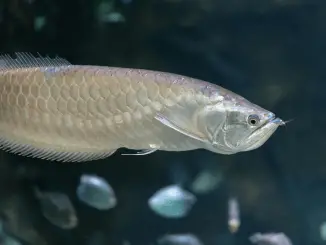
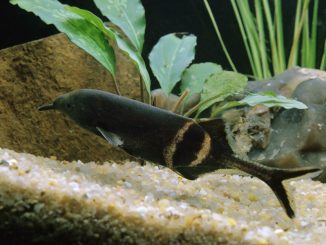
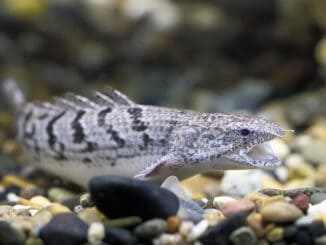
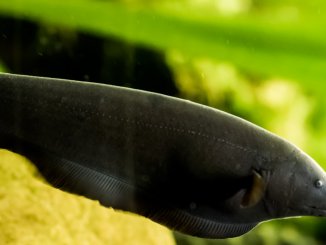
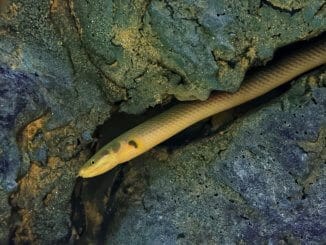
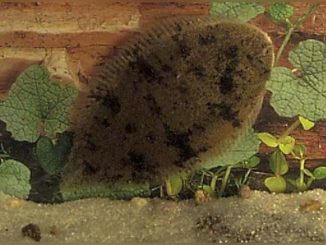
Good info thank so much..i’m just want to start buy a super red arowana as a new hobby..